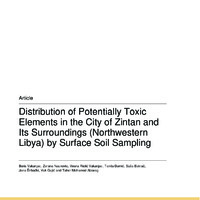Distribution of Potentially Toxic Elements in the City of Zintan and Its Surroundings (Northwestern Libya) by Surface Soil Sampling
Објеката
- Тип
- Рад у часопису
- Верзија рада
- објављена верзија
- Језик
- енглески
- Креатор
- Boris Vakanjac, Zorana Naunović, Vesna Ristić Vakanjac, Tanita Đumić, Saša Bakrač, Jana Štrbački, Vuk Gajić, Taher Mohamed Alzarog
- Извор
- Minerals
- Издавач
- MDPI AG
- Датум издавања
- 2023
- Сажетак
- The study area is the city of Zintan, in northwestern Libya, which has grown over the past 30 years. Its current population is roughly 30,000. Although the city is in part commercial, most of the population engages in agriculture and primarily grows cereal crops (wheat and barley). The demand of the growing city for agricultural products has increased, intensifying the use of fertilizers, pesticides, and insecticides. Consequently, concentrations of potentially toxic elements (PTE) in the soil have increased. To assess the soil quality (to provide a snapshot of the condition of the soil), systematic sampling was undertaken across a grid of about 2 km × 2 km. The main objective was to determine the chemical and mineral composition of the area of interest, keeping in mind the geological footprint of the terrain. The geologic framework itself is not conducive to elevated concentrations of elements like U, Th, Mo, As, Hg, Pb, and Cr. Therefore, metal concentrations greater than the amounts in the Earth’s crust are most likely of anthropogenic origin. A total of 143 samples were collected and chemical analyses were performed using a Thermo Fisher Scientific Niton XL3t GOLDD+ XRF analyzer for the following elements: Mo, Zr, Sr, U, Rb, Th, Pb, Au, Se, As, Hg, Zn, W, Cu, Ni, Co, Fe, Mn, Cr, V, Ti, Sc, Ca, K, S, Ba, Cs, Te, Sb, Sn, Cd, Pd, and Ag. This paper provides examples of elevated concentrations, potentially harmful to the environment, such as those of the following: sulfur of unknown origin (two to three times higher than the Earth’s crust average); arsenic, given that there are no related natural phenomena (all the samples measured displayed concentrations higher than those found in the Earth’s crust); mercury (concentrations much higher than permissible levels); cesium (additional investigations required to determine the origin); molybdenum; and uranium likely resulting from the use of superphosphates (concentrations nearly always significantly higher than those in the Earth’s crust).
- том
- 13
- Број
- 8
- број страница
- 23
- doi
- 10.3390/min13081048
- issn
- 2075-163X
- Просторно покривање
- Northwestern Libya
- Subject
- Geologija, Geotehničko inženjerstvo, Inženjerska geologija
- Geology, Geotechnical Engineering, Engineering Geology
- Шира категорија рада
- M20
- Ужа категорија рада
- М22
- Права
- Отворени приступ
- Лиценца
- Creative Commons – CC0 Public Domain
- Формат
Boris Vakanjac, Zorana Naunović, Vesna Ristić Vakanjac, Tanita Đumić, Saša Bakrač, Jana Štrbački, Vuk Gajić, Taher Mohamed Alzarog. "Distribution of Potentially Toxic Elements in the City of Zintan and Its Surroundings (Northwestern Libya) by Surface Soil Sampling" in Minerals, MDPI AG (2023). https://doi.org/10.3390/min13081048
This item was submitted on 22. септембар 2023. by [anonymous user] using the form “Рад у часопису” on the site “Радови”: http://dr.rgf.bg.ac.rs/s/repo
Click here to view the collected data.
